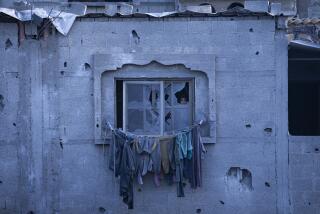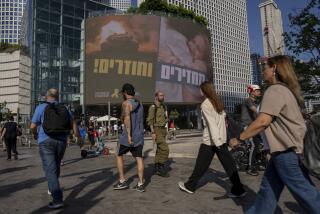A Traumatized City Goes Back to Work
- Share via
NEW YORK — In some ways, it could have been any weekday, with the suited masses riding suburban trains, the subways disgorging the workaday hordes, and the great swarms of workers waiting at the elevator doors.
But Monday was a day unlike any other, with New Yorkers seized by an aching desire--a primal need--for the routine, the familiar, the ordinary. And it was all so hard to find.
In the freshly reopened financial district, there were checkpoints and traffic snarls, smoke and stink and barricades. Some of the police toted automatic rifles. National Guardsmen wearing gas masks patrolled the canyons of Wall Street. Yellow police tape flowed like confetti. It seemed every other person wore a paper dust mask.
In the end, getting back to the business of business was traumatic. The World Trade Center towers, icons of U.S. capitalism and commerce, had been gone for six full days. Gone too was the bedrock assumption that you go to work every day and return home safely each night.
Things were different now, and everybody knew it.
“It’s sort of spooky seeing five brokers and 800 policemen,” said Angelo Pomes of the brokerage firm Prosperitas Management.
Jimmy Reilly, 41, a stockbroker hustling to work, saw the upside. “It’s good to be alive,” he said.
Danny Debetta, 24, a New York Stock Exchange floor clerk awaiting the market bell, had a bad feeling. He thought it was too soon to bring the markets back.
“The mood’s not good,” he said.
Moments later, the day began badly and ended worse. The stock exchange dropped 143 points eight minutes after rescue workers rang the opening bell--and then plummeted 684.81 points by day’s end.
But even the largest point drop in history seemed to many, including Mayor Rudolph W. Giuliani, a fleeting setback given the events of the previous week. The mayor brushed off the losses and, as he has for six relentless days, pushed and prodded New Yorkers to charge ahead.
“This is important,” he said of Wall Street’s return to life. “It’s important for the American economy, and it’s important for the spirit of the city. . . . We have an obligation to carry on with the rest of our lives.”
USA Patches, Flags Help Lift Workers’ Spirits
Symbols of patriotism helped. At the stock exchange, brokers pinned flags to their backs and stitched “USA” patches to their sleeves. Tiny flags adorned most computer monitors. The words “God Bless America” scrolled across the bottom of each monitor, where market updates normally are flashed.
Outside City Hall, Marine Corps veteran Steve Adams of Queens greeted commuters with a 5-by-8-foot Stars and Stripes attached to a long pole. “I didn’t want people to just resume going about their normal business like nothing happened,” he said.
Vilma Hampton, who works for a company that makes Bible verse wrappers for rolls of mints, was feeling anything but normal. “On the outside, we’re all trying to go on normally,” she said. “But on the inside, everyone is walking around a little suspicious. You can feel it.”
There was nothing ordinary about the opening of the stock exchange. Brokers bowed their heads for two minutes of silence to honor the dead and missing. Some prayed, and some wept.
As a Marine Corps officer sang “God Bless America,” exchange Chairman Richard Grasso found himself crying. He reached back and gripped Giuliani’s hand.
A lot of people needed extra support Monday. Jeff Katz, 27, who works the foreign exchange desk at the Goldman Sachs Group Inc., knows dozens of people missing and feared dead in the ruins of the trade center.
“I can’t imagine doing my job with all this stuff going on around me,” he said. “It seems kind of pointless.”
People were feeling wounded and raw, and barely inclined to think much about jobs or offices or paperwork.
“You have to be numb to come in and think it’s a regular day,” said Nick Matera, 55, a broker assistant.
Liz Frankini, a receptionist on her way to work at a real estate firm in midtown Manhattan, was studying a newspaper list of missing police officers and firefighters. She was searching for the name of a friend, a firefighter from Brooklyn.
Asked how she felt, she could only reply, “Scared. I’m a little traumatized.”
Number of Missing Surpasses 5,000
Even with daily routines slowly coming into focus, Monday was another heartbreaking day for the families of the missing. For the first time, the number of people reported missing climbed past 5,000, to 5,422. Officials did not explain the increase. The number of confirmed dead rose to 201, with 135 identified.
The statistics came, as they have every day, from Giuliani, whose face was drawn by the time he left Wall Street and toured the wreckage of the trade center. His words to the families of the missing were more direct than on any previous day. “I have to say to people: Don’t have high expectations about this,” the mayor said. “People should start absorbing that and thinking of that.”
It wasn’t that rescuers were abandoning all hope, he said. In fact, he said, experts were still telling him that people can survive a week buried alive.
“But we’re not at a point where we can say we will recover large numbers of people alive,” he said.
Somebody asked Giuliani how he would know when the day had come to stop looking for the living, and to focus on bringing out the dead.
He did not hesitate. “I’ll stop when the people there tell me there is no hope anymore,” he said. “They haven’t reached that point yet.”
At the mayor’s briefing, there were more numbers. The amount of debris removed from the disaster site reached 39,416 tons. Neither the mayor nor Fire Commissioner Thomas Van Essen had any idea how many tons remained to be cleared. “A lot more,” Van Essen said finally.
In Manhattan, meanwhile, some shoppers accepted Giuliani’s challenge to, as he put it, “come to New York and spend money.”
At Malo, an emporium on Madison Avenue, a longtime customer bought several sweaters and a dress--by phone. The tab came to $11,000.
“People are apologetic. Clothing seems so trite at a time like this,” said Malo’s manager, Ray Lechler.
At Vera Wang, where shopping is by appointment only, a woman considered a $9,000 wedding dress in the window. Pinned to the bodice was an American flag.
People sought therapy in various ways.
At St. Patrick’s, Tears for Victims
For some, solace came at St. Patrick’s Cathedral, where New Yorkers lined up by the thousands for a memorial service for dead or missing uniformed personnel. Only family members were invited, but the lines swelled into the night. Some people cried. Some prayed. They all paid their respects.
As night fell over the disaster site on a day when the FBI announced it had completed its search for evidence on surrounding rooftops and streets, there was a sense that a routine was slowly being established: Workers tear at the wreckage. Trucks haul debris away. The mountains of rubble shrink, terribly slowly. But no one has been pulled out alive since five victims were rescued Wednesday.
Ironworker Jim Benson took a break from helping pull apart the wreckage. Asked whether he thought anyone would be found alive, Benson said quietly, “I just don’t think so.”
By the end of the day, even with the markets in free fall and reports of traffic jams pouring in, Giuliani sounded positive. As he moved around the city--from the stock exchange to his first City Hall meeting in a week and on to the disaster site--he seemed determined to shrink the dimensions of the tragedy through sheer perseverance.
He even joked about the plummeting markets. “Sounds like a great time to buy to me,” he cracked.
All in all, the mayor suggested, this long strange day in New York was an effort worth pursuing. He offered a modest assessment: “Today is a day like many we will have to face.”
*
Times staff writers David Zucchino, John Goldman, Matea Gold, Jeffrey Gettleman, Charles Ornstein and Ralph Frammolino contributed to this story.
More to Read
Sign up for Essential California
The most important California stories and recommendations in your inbox every morning.
You may occasionally receive promotional content from the Los Angeles Times.













